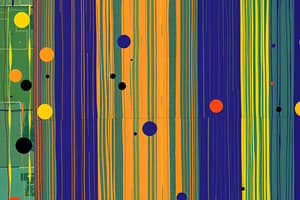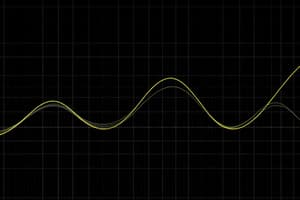Podcast
Questions and Answers
What is the primary goal of supervised learning in the context of regression problems?
What is the primary goal of supervised learning in the context of regression problems?
- To optimize the storage of data
- To identify clusters within the dataset
- To classify data into distinct categories
- To predict real-valued outputs based on input data (correct)
Which of the following represents a common application of supervised learning?
Which of the following represents a common application of supervised learning?
- Generation of synthetic datasets
- Searching and indexing of unstructured information
- Unsupervised clustering of data
- Automatic classification of images (correct)
In the housing prices dataset, what does the variable x represent?
In the housing prices dataset, what does the variable x represent?
- The price of the house in thousands of dollars
- The age of the house in years
- The number of bedrooms in the house
- The size of the house in square feet (correct)
Considering the provided dataset, how can you visualize the relationship between house size and price?
Considering the provided dataset, how can you visualize the relationship between house size and price?
What is the typical output of a regression analysis when applied to the housing prices data set?
What is the typical output of a regression analysis when applied to the housing prices data set?
What is the purpose of plotting a pair-wise classification of feature data?
What is the purpose of plotting a pair-wise classification of feature data?
Which of the following is NOT a listed type of feature extraction?
Which of the following is NOT a listed type of feature extraction?
Which machine learning concept involves both labeled and unlabeled data?
Which machine learning concept involves both labeled and unlabeled data?
What can indicate a good feature in classification tasks?
What can indicate a good feature in classification tasks?
What type of learning is primarily focused on making predictions based on input-output pairs?
What type of learning is primarily focused on making predictions based on input-output pairs?
Which machine learning algorithm is based on instances and does not assume a specific distribution?
Which machine learning algorithm is based on instances and does not assume a specific distribution?
Which of the following is a feature extraction technique that focuses on frequency analysis?
Which of the following is a feature extraction technique that focuses on frequency analysis?
Which classification method is likely to result in the most overlapping of classes?
Which classification method is likely to result in the most overlapping of classes?
Which of the following best describes unsupervised learning?
Which of the following best describes unsupervised learning?
Which application is NOT associated with clustering in unsupervised learning?
Which application is NOT associated with clustering in unsupervised learning?
What is a key characteristic of a training set used in supervised learning?
What is a key characteristic of a training set used in supervised learning?
Which clustering algorithm application helps in the organization of computing resources?
Which clustering algorithm application helps in the organization of computing resources?
What is the primary goal of using clustering in social network analysis?
What is the primary goal of using clustering in social network analysis?
What does the variable 'x' represent in the training set?
What does the variable 'x' represent in the training set?
In the context of linear regression with one variable, what does the hypothesis 'h' signify?
In the context of linear regression with one variable, what does the hypothesis 'h' signify?
Which of the following definitions is correct for 'y' in the training set?
Which of the following definitions is correct for 'y' in the training set?
How can one select the best regression line for a dataset?
How can one select the best regression line for a dataset?
What does the term 'parameters' refer to in the hypothesis used for linear regression?
What does the term 'parameters' refer to in the hypothesis used for linear regression?
Which data does the training set NOT include?
Which data does the training set NOT include?
What is the primary output of a linear regression model when estimating prices?
What is the primary output of a linear regression model when estimating prices?
Which factor is critical in determining the effectiveness of a regression line?
Which factor is critical in determining the effectiveness of a regression line?
What does the joint probability distribution provide for a set of random variables?
What does the joint probability distribution provide for a set of random variables?
Which statement correctly defines prior probability?
Which statement correctly defines prior probability?
What is the chain rule relevant to in probability?
What is the chain rule relevant to in probability?
In Bayesian rule, what is required to calculate P(C | X)?
In Bayesian rule, what is required to calculate P(C | X)?
What does conditional probability express in relation to two events A and B?
What does conditional probability express in relation to two events A and B?
Which of the following defines independence between two events A and B?
Which of the following defines independence between two events A and B?
What does the product rule in probability involve?
What does the product rule in probability involve?
What is an example of a percentage probability in Bayesian statistics as provided?
What is an example of a percentage probability in Bayesian statistics as provided?
Which of the following best describes feature extraction in a machine learning system?
Which of the following best describes feature extraction in a machine learning system?
When calculating P( infection | fever), which values contribute to the numerator?
When calculating P( infection | fever), which values contribute to the numerator?
In the context of conditional probability, what does P(A | B) represent?
In the context of conditional probability, what does P(A | B) represent?
Which aspect is critical for performing inference in a machine learning system?
Which aspect is critical for performing inference in a machine learning system?
What does P(Weather, Infection) = P(Weather | Infection) P(Infection) imply?
What does P(Weather, Infection) = P(Weather | Infection) P(Infection) imply?
What is a fundamental component of the machine learning system as per the review?
What is a fundamental component of the machine learning system as per the review?
What is the primary goal of selecting parameter values in training examples?
What is the primary goal of selecting parameter values in training examples?
Why is a squared error function preferred in regression problems?
Why is a squared error function preferred in regression problems?
What does adding a constant 2 to the denominator of the cost function achieve?
What does adding a constant 2 to the denominator of the cost function achieve?
In the context of hypothesis functions, what does varying parameter values allow us to do?
In the context of hypothesis functions, what does varying parameter values allow us to do?
What kind of learning method is described for automatically adjusting parameter values?
What kind of learning method is described for automatically adjusting parameter values?
What does the contour line of the cost function represent?
What does the contour line of the cost function represent?
What is the effect of a local optimum in cost minimization?
What is the effect of a local optimum in cost minimization?
How does the variable 'x' relate to the hypothesis function?
How does the variable 'x' relate to the hypothesis function?
What is an essential characteristic of a cost function in regression?
What is an essential characteristic of a cost function in regression?
What is typically aimed for in hypothesis function adjustments?
What is typically aimed for in hypothesis function adjustments?
What feature does the cost function help to optimize in training models?
What feature does the cost function help to optimize in training models?
What intuition does the cost function provide in relation to the hypothesis function?
What intuition does the cost function provide in relation to the hypothesis function?
What does 'sensitivity to starting points' imply in gradient descent?
What does 'sensitivity to starting points' imply in gradient descent?
When plotting values on the cost function's contour line, what should be observed?
When plotting values on the cost function's contour line, what should be observed?
Flashcards
Linear Discriminant Analysis
Linear Discriminant Analysis
A method in taxonomy that uses multiple measurements to distinguish between different classes of data.
Feature Extraction
Feature Extraction
The process of selecting or creating useful data points (features) from raw data for a machine learning model.
Good Features
Good Features
Features in data that show little overlap between different classes, making classification easier.
Bad Features
Bad Features
Signup and view all the flashcards
Supervised Learning
Supervised Learning
Signup and view all the flashcards
Unsupervised Learning
Unsupervised Learning
Signup and view all the flashcards
Iris Data Class
Iris Data Class
Signup and view all the flashcards
Feature Names
Feature Names
Signup and view all the flashcards
Regression Problem
Regression Problem
Signup and view all the flashcards
Linear Regression
Linear Regression
Signup and view all the flashcards
Clustering Algorithm
Clustering Algorithm
Signup and view all the flashcards
Housing Prices Data Set
Housing Prices Data Set
Signup and view all the flashcards
Market Segmentation
Market Segmentation
Signup and view all the flashcards
Social Network Analysis
Social Network Analysis
Signup and view all the flashcards
Real-valued output
Real-valued output
Signup and view all the flashcards
Prior Probability
Prior Probability
Signup and view all the flashcards
Conditional Probability
Conditional Probability
Signup and view all the flashcards
Joint Probability
Joint Probability
Signup and view all the flashcards
Bayes' Rule
Bayes' Rule
Signup and view all the flashcards
Independent Events
Independent Events
Signup and view all the flashcards
Machine Learning System
Machine Learning System
Signup and view all the flashcards
Iris Data Set
Iris Data Set
Signup and view all the flashcards
Data Preprocessing
Data Preprocessing
Signup and view all the flashcards
Feature Vectors
Feature Vectors
Signup and view all the flashcards
Training Examples
Training Examples
Signup and view all the flashcards
Classifier
Classifier
Signup and view all the flashcards
Inference by Enumeration
Inference by Enumeration
Signup and view all the flashcards
Product Rule
Product Rule
Signup and view all the flashcards
Chain Rule
Chain Rule
Signup and view all the flashcards
Bayes' Theorem
Bayes' Theorem
Signup and view all the flashcards
Training set
Training set
Signup and view all the flashcards
Input variable (x)
Input variable (x)
Signup and view all the flashcards
Output variable (y)
Output variable (y)
Signup and view all the flashcards
Hypothesis (h)
Hypothesis (h)
Signup and view all the flashcards
Parameters (s)
Parameters (s)
Signup and view all the flashcards
Regression line
Regression line
Signup and view all the flashcards
Cost Function
Cost Function
Signup and view all the flashcards
Objective Function
Objective Function
Signup and view all the flashcards
Hypothesis
Hypothesis
Signup and view all the flashcards
Parameters
Parameters
Signup and view all the flashcards
Squared Error Function
Squared Error Function
Signup and view all the flashcards
Gradient Descent
Gradient Descent
Signup and view all the flashcards
Local Optima
Local Optima
Signup and view all the flashcards
Global Minimum
Global Minimum
Signup and view all the flashcards
Learning Algorithm
Learning Algorithm
Signup and view all the flashcards
Study Notes
Week 3 Review of Machine Learning
- The week covered a review of machine learning concepts, including probability, Bayes' rule, and a machine learning system overview.
- A key component of the review was revisiting and completing probability topics from previous sessions.
- The presentation included a real-life historic data set collection example, highlighting the significance of feature extraction.
- This week also focused on the structure of a full machine learning system.
Probability and Bayes' Rule
- Prior probabilities, conditional probabilities (e.g., P(X₁|X₂), P(X₂|X₁)), and joint probabilities (e.g., P(X₁) = P(X₁, X₂)) describe the probabilities of events.
- Independent events are when P(X₂|X₁) = P(X₂).
- Conditional probability is calculated using the Bayes' rule: P(X|C) = (P(X|C) * P(C)) / P(X).
Probability Basics
- Prior probability: The probability of an event occurring before any evidence is considered.
- Conditional probability: The probability of an event occurring given that another event has already occurred.
- Joint probability: The probability of multiple events occurring simultaneously.
- The relationship between these is often expressed using the product rule.
- Independence: Events are independent if their occurrence does not affect the probability of another event's occurrence.
Prior Probability
- Prior probabilities represent beliefs before observing any new evidence.
- Given Example: P(Infection = true) = 0.2 and P(Weather = sunny) = 0.72.
Joint Probability Distribution
- The joint probability distribution details the probability of each combination of events.
- Example: A matrix presents the probabilities of weather conditions (sunny, rainy, cloudy, snowy) paired with infection status (true/false).
Conditional Probability
- Conditional probabilities represent probabilities given specific conditions or evidence.
- Example: P(Infection | fever) = 0.8 means the probability of an infection given fever evidence is 0.8.
- Conditional probabilities are updated with new evidence.
Inference by Enumeration
- Inference relies on the joint probability distribution.
- Starting with the provided joint probability distribution, various probabilities can be calculated.
- Joint probability tables exemplify the calculation of conditional probabilities.
Independence
- Two events (A and B) are independent if P(A|B) = P(A).
- The independence of events can be used to simplify complex probability calculations. Example provided involving weather, infection, blood tests etc.
Bayes' Rule
- A fundamental rule for updating probabilities given new evidence, crucial in many machine learning models.
- Bayes' rule relates diagnostic to causal probabilities.
- Example in the presentation: P(S|H) = P(H|S) * P(S) / P(H).
A Machine Learning System
- A system for building machine learning models comprises steps;
- From raw data to clean data, feature extraction, vectorization, machine learning, testing, and classifier output.
Data Collection with Manual Feature Extraction
- The Iris data set is a well-known multivariate data set.
- Used for linear discriminant analysis to distinguish flower species (versicolor, setosa, virginica).
- 150 flower samples with features like sepal length, sepal width, petal length, and petal width are recorded.
Iris Data Class
- The Iris flower dataset has 3 classes/species: setosa, versicolor, and virginica.
- Each class contains 50 samples/flowers.
Evaluation
- Feature quality is assessed using pair-wise scatter plots and visualizations.
- Overlapping classes indicate poor feature distinctions for classification.
- Good features result in clear classifications with minimal overlap between classes.
Feature Extraction
- Features are extracted from raw data to prepare it for machine learning tasks.
- Various methods to extract features from raw data include: entropy-based, statistical, wavelet transform, fourier transforms, convolutions.
Example of Good vs. Bad Features
- Good features allow easy classification, and clear distinctions are available.
- Bad features lead to significant overlap and classification difficulties.
Machine Learning Algorithms Review
- Algorithms like KNN, Linear Regression, Regularization, Logistic Regression, Bayesian and more are reviewed.
- Supervised and unsupervised machine learning algorithms, examples given, and applications are showcased.
Supervised learning
- A type of learning model whereby the inputs (x) are paired with desired outputs (y) values from the start.
Unsupervised learning
- Grouping (clustering) based on data points similar to one another
Applications of Clustering
- Uses include market segmentation, social network analysis (identification of groups), organization of computing clusters, and astronomical data analysis.
Supervised Learning Applications
- Examples include service robots, scientific and astronomical studies, medical diagnosis, industry applications, and search engine indexing.
Linear Regression with One Variable
- A supervised learning model for predicting a continuous output from an input.
Housing Prices Data Set
- A dataset includes housing prices in thousands of dollars and the size in square feet from a city.
Hypothesis
- A hypothesis in linear regression is a prediction line, capturing the relationship between inputs and outputs.
Parameters
- The parameters (θ's) in a hypothesis function define the specific values in the prediction line.
Cost Function
- A cost function quantifies the difference/error between predictions (ho(x)) and observed values (y).
Goal
- The goal is to find optimal parameters that minimize the cost function to produce the best or closest match possible to true values in real-life.
Gradient Descent Learning
- A method for finding the optimal values of parameters (θ's) that are to be minimized in the cost function (J).
- Gradient descent iteratively adjusts parameters to reduce the cost function's error, and uses derivative (slope of error surface) to guide these changes.
Gradient Descent Intuition
- Understanding the behavior and dynamics of adjusting parameters and minimizing errors.
Gradient Descent Algorithm
- A step-by-step process for updating parameter values using a learning rate to reach a "minimum" cost in the model fitting and reduce model error.
Studying That Suits You
Use AI to generate personalized quizzes and flashcards to suit your learning preferences.




